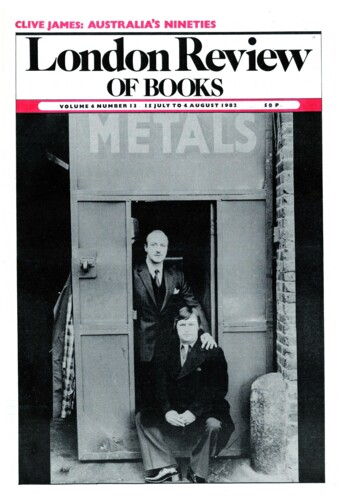The unnamed narrator of John Banville’s novel is an academic who spends the summer on a run-down country estate in Ireland where he hopes to put the finishing touches to a book on Isaac Newton. Gradually, his research takes a back seat as he becomes fascinated with the family on whose property he is living. Edward Lawless is a wreck of a man, clumsy, inarticulate, frequently drunk; his wife Charlotte is noble, suffering, strangely withdrawn; Ottilie, Charlotte’s niece, is blonde, somewhat graceless, but physically available. Even in the physical abandon of his love-making with Ottilie, the narrator’s heart – and mind – are not in it. Inwardly, he is obsessed with Charlotte, and it is her image which informs – and, to a certain extent, deforms – the relationship with Ottilie. By the end of the story the narrator learns a number of lessons: he realises that many of the images and patterns he has established for himself and for those around him are false. The Lawless family are not genteel Protestant aristocracy in decline; Edward is not the brute of the narrator’s account, he is dying of cancer; Charlotte’s mysteriousness has more to do with the tranquillisers she has been taking in order to cope with the horror of her husband’s decline than with any mysterious Iris Murdoch-like spiritual drama. The ‘illustration from a Victorian novelette’, the ‘old novels’, the ‘echo of some old brown painting’ – such exercises in cultural image-making founder before the authority of simple fact. The narrator comments: ‘I dreamed up a horrid drama, and failed to see the commonplace tragedy that was playing itself out in real life.’ The sophistication of the knowing mind proves brittle and irrelevant. As Ottilie puts it: ‘You think you’re so clever, but you don’t know a thing.’ The ordinary has the last word.
This breakthrough of the commonplace is linked with the breakdown of the book on which the narrator is working. He is fascinated by Newton’s nervous collapse in 1693, a crisis which is no mere psychological disturbance: Newton’s (fictitious) letter to Locke reports a profound change whereby the ‘lofty verities of science’, the austere splendour of laws and patterns, have crumbled before the abundant truth of commonplace, unremarkable being. Newton’s crisis, then, is of a piece with his biographer’s.
‘Shall I say, I’ve lost my faith in the primacy of the text?’ the narrator asks at the beginning of his account. Well, yes and no. Given that the theme of Banville’s novel is the destruction of certain kinds of textuality, one would assume that its actual mode would necessarily be overtly unpatterned, devoted to unmediated rawness of the ‘let-it-all-hang-out’ school – or to a kind of chosiste prose of constatation. But this is far from being the case. The Newton Letter is no loose baggy monster. Rather, it manipulates a particular kind of intertextuality in order to supplant one kind of text by another. The discovery of humble being, of the radiance inhering in the particular, of the truth of objects in their ‘innocence’, ‘their non-complicity in our affairs’, is part of a particular intertextual continuity. As Banville acknowledges in a postscript, Newton’s letter, in spirit and in some of its formulations, derives from Hofmannsthal’s ‘Chandos’ letter. The title of Banville’s novel alludes, then, to another text. Moreover, when the narrator speaks of commonplace objects ‘requiring us far more desperately than I do them’, when he exults in the particular physical memory of Ottilie by writing that ‘supernumerous existence wells up in my heart,’ then we hear the voice and the redemptive affirmation of ‘things’ which we associate with Rilke.
Compounding this density of textual reverberation, we have the all-pervasive, formative presence of Goethe’s novel The Elective Affinities. The names of the characters (Charlotte, Edward, Ottilie, Mittler), the ‘spiritual adultery’ of the narrator’s relationship with ‘Charlottilie’ – all this makes it clear that Banville is inviting us to perceive his novel as a debate conducted with – and through – Goethe’s unforgettable study of the place of image, picture and pattern within the flux of human eros (‘knowing’ in both senses of the word). Goethe, with his dislike of Newtonian science, would have approved. He would also have approved of Banville’s refusal to be reductive. Commonplace facts – Edward’s cancer – may have the last word. But inseparable from that matter-of-factness is the celebration of humble things and circumstances that are outside (but not excluded from) the human acts of perception, comprehension and symbolisation. The narrator writes of Edward: ‘I can’t recall what he said, what words he used. The subject was the countryside, farming, something banal. But what he was talking about, I suppose, was his sense of oneness now with all poor dumb things, a horse, a tree, a house, that suffer their lives in silence and resigned bafflement, and die unremarked.’ At one level, the process the narrator undergoes is one of moral growth. His stylistic love affair with drainpipes, Wellington boots, with concrete particulars, serves to redeem the physical (but not merely physical) truth of his feelings for Ottilie.
John Banville has written a compassionate and vibrantly intelligent novel – and also a timely one. Readers of the recent plagiarism debate in the TLS will find here a book whose indebtedness to other literary works has nothing to do with derivativeness – nor with a self-regarding pan-literariness. Rather, Banville reminds us of the ways in which, and of the extent to which, literature can legitimately be made out of the issue of its own mode and being – and can thereby address profound issues of human cognition and behaviour.
Send Letters To:
The Editor
London Review of Books,
28 Little Russell Street
London, WC1A 2HN
letters@lrb.co.uk
Please include name, address, and a telephone number.

